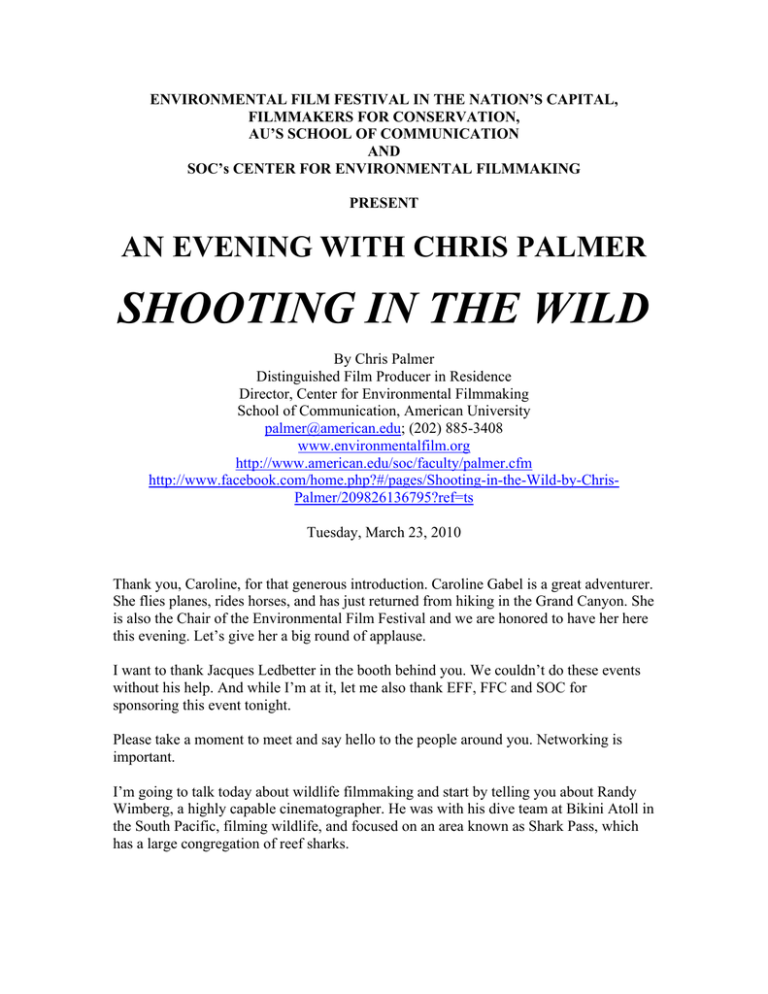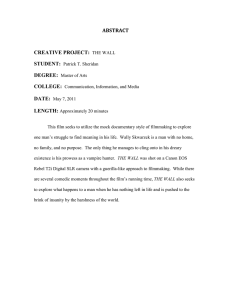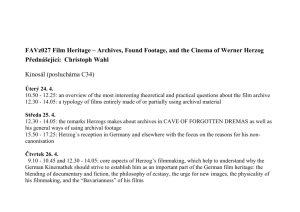ENVIRONMENTAL FILM FESTIVAL IN THE NATION’S CAPITAL, FILMMAKERS FOR CONSERVATION,
advertisement

ENVIRONMENTAL FILM FESTIVAL IN THE NATION’S CAPITAL, FILMMAKERS FOR CONSERVATION, AU’S SCHOOL OF COMMUNICATION AND SOC’s CENTER FOR ENVIRONMENTAL FILMMAKING PRESENT AN EVENING WITH CHRIS PALMER SHOOTING IN THE WILD By Chris Palmer Distinguished Film Producer in Residence Director, Center for Environmental Filmmaking School of Communication, American University palmer@american.edu; (202) 885-3408 www.environmentalfilm.org http://www.american.edu/soc/faculty/palmer.cfm http://www.facebook.com/home.php?#/pages/Shooting-in-the-Wild-by-ChrisPalmer/209826136795?ref=ts Tuesday, March 23, 2010 Thank you, Caroline, for that generous introduction. Caroline Gabel is a great adventurer. She flies planes, rides horses, and has just returned from hiking in the Grand Canyon. She is also the Chair of the Environmental Film Festival and we are honored to have her here this evening. Let’s give her a big round of applause. I want to thank Jacques Ledbetter in the booth behind you. We couldn’t do these events without his help. And while I’m at it, let me also thank EFF, FFC and SOC for sponsoring this event tonight. Please take a moment to meet and say hello to the people around you. Networking is important. I’m going to talk today about wildlife filmmaking and start by telling you about Randy Wimberg, a highly capable cinematographer. He was with his dive team at Bikini Atoll in the South Pacific, filming wildlife, and focused on an area known as Shark Pass, which has a large congregation of reef sharks. 2 Crew members built a cage to protect him from danger, but they removed some of the panels to give the camera an unobstructed view. When he first saw the cage, Randy thought the gap in the sides of the cage looked larger than necessary. The plan was for Randy to be in the cage while someone in the nearby support boat threw chum into the water to attract the sharks. Randy climbed into the cage and was eased out on a tether about fifteen feet from the boat. When a deckhand threw in the chum, reef sharks quickly showed up in large numbers. Some of the chum drifted into the cage. Randy watched helplessly as frantic sharks began crashing into the cage, tearing at chunks of food caught in the wire mesh. Soon more than thirty sharks were competing for food that was either stuck to the cage or drifting through it. Suddenly a shark shot right through the gap and exited out the other side of the cage, grazing Randy as it passed. He tried to remain calm, the camera still rolling. He was frantically batting away sharks with his camera, but there were too many of them and too much chum. Another shark shot through the gap. To Randy’s horror, it didn’t pass smoothly out the other side. Instead the shark ended up in the bottom of the cage and started thrashing wildly. Randy tried to curl up in the corner of the cage to escape the frightened animal. He knew that the shark felt very threatened and would use the only defense it had—its teeth and jaws. Randy desperately attempted to push the animal up toward the exit with his camera, but that didn’t work. He decided his only chance was to get himself out. As he edged toward the opening in the cage, his teammates in the boat saw what was happening and began raising the cage to the surface. And before the shark could get in a position to bite, Randy scrambled out of the cage and into the boat. The shark was released unhurt. Let’s recognize and salute Randy’s bravery! This is typical of wildlife cameraman. They are brave and courageous. Now please get in pairs with someone you don’t know, and I’ll give you about one minute to brainstorm about what went wrong. Go! • Why had the deckhand thrown so much chum in the water? Was he acting on instructions from the producer? Was Randy Wimberg’s life—and the shark’s— needlessly endangered for the sake of getting exciting footage to help push up the show’s ratings? • This incident was all about getting the “money shot.” A cameraman in a protective chain-mail suit was swimming twenty feet below Randy and filmed the whole incident. The producer knew that the more dramatic the action, the more successful the film might be. In fact, Randy’s brush with disaster became a high point in the film. 3 • The film’s audiences were misled. They didn’t know about the chum, so many viewers went away thinking that such frenzied feeding behavior happens naturally. • The cause of conservation was ill served. At a time when shark populations are shrinking worldwide, sharks were being unfairly portrayed as ferocious attackers. You could argue, now that we’ve talked about it, that what went wrong in the incident with Randy Wimberg is fairly obvious, but making ethically correct choices in wildlife filmmaking isn’t always obvious. For example, suppose you are making a film about chimps. You know that violence (or any extreme behavior) fascinates people and that chimps sometimes hunt for prey, such as other primates. You know that viewers will be shocked, even horrified by the bloodthirsty brutality of the chimps, and the ratings will be big. Yet you also know that meat makes up only about two percent of the chimpanzees’ diet. Mostly they feed on fruits, leaves, and other plant material. By serving up a series of hunts, your film shows a far more violent picture of chimpanzee nature than is actually the case. It gives a wrong impression. Is the film unethical? Or imagine you are a producer and you want a shot of a spider eating a fly. It’s obvious you have to stage it because you don’t have the money to wait around for weeks for it to happen naturally. But how far will you go with staging? For example, you also want a shot of a boa constrictor eating a monkey. Do you stage that as well? In other words, capture a boa constrictor, capture a monkey, put them in an enclosure and film the resulting predation? It’s routine predatory behavior and happens all the time, and your film will promote conservation. Do the ends justify the means? Is it ethical to stage it? Or imagine you’re in Africa with Jeff Corwin and your goal is for him to find a rare lizard, not seen for 25 years. This is to be the climax of the film. You search for days with no luck, but finally the rare lizard is found, not by Jeff Corwin, but by a local African tracker who barely speaks English. You put the animal back where it was found, and let Jeff “discover” it and act surprised for the camera, thus capturing for your film an emotional highpoint. Is that bit of acting by Jeff Corwin unethical? These are tough questions and I’ll give you my answers to those three scenarios shortly. To explore these ethical issues further, I now want to show you some clips from films I produced. You may be shocked by what I’m going to tell you. Whales (Show scene with Kim in water swimming with right whales) • We had just one day left, the weather was closing in, our budget was exhausted, and we were almost in a state of panic because we hadn’t got the shots of whales we wanted. 4 • The scene was created solely for the film. It was all set up. Kim’s swim wouldn’t have happened if our cameras hadn’t been there. • We used recorded whale sounds to draw whales close in where our IMAX cameras could film them. • Topside and underwater shots were captured weeks apart, although we gave the impression in the film that it was all shot at the same time on the same day. • BTW, one good thing: We shot from high up on the cliff, so the whales were unaware of us and behaved naturally • [Misty and Echo made-up story—poetic license.] Wolves (Show scene with pack of wolves having pups, etc.) • Those wolves were captive and controlled, although the audience has no idea of that and naturally thinks they’re wild. The wolves come from a game farm, where they live very stressful lives in small cages without space to roam. I discuss game farms in detail in my book. • The den where the mother wolf suckles her new born pups is artificial and was manufactured. • The one positive thing about using captive animals is that it means the film crew doesn’t have to interfere with and disturb wild, free-ranging animals and habituate them to people. Bears (Chris Day in Alaska with brown bears) • We put the paw print in the sand, and we put the bones on the river bank for Chris Day to find. • We wanted close up shots of bears but couldn’t get that footage with truly wild bears, so we used captive bears from a game farm, and had to film them in a different ecosystem. • Chris Day also gets too close, although the long lens distorts the distances and she’s not as close as she looks. Still, I’ve criticized Steve Irwin and Jeff Corwin for getting too close to animals, but when people saw this film, they felt I’d done the same thing and quite rightly criticized me. What can we learn from these clips? There are three primary issues with wildlife films. First, are audiences deceived and misled by these kinds of films, and if so, does it matter? Second, are wild animals harassed and disturbed during filming? And third, is conservation advanced by these films? Do they make any difference? 5 First, is the audience deceived and mislead? When does legitimate filmmaking artifice become unacceptable deception? When I was a teenager growing up in England, Life Magazine carried a dramatic prizewinning sequence of photographs showing a leopard hunting a baboon. It was thrilling and dramatic. The final picture showed the leopard crushing the baboon’s skull in its jaws. Later it was shown to be all staged with a captive leopard and a captive and terrified baboon. Such cruel staging and manipulation is grossly unethical in three ways: viewers are deceived, animals are abused, and the photographer competes unfairly with those who wait patiently for weeks, even months, to get a similar but real shot. When I first got into television in the early 1980s, I brought home a film my colleagues and I had just completed to show my wife, Gail. She especially liked a close-up scene of a grizzly bear splashing through a stream and asked me how we were able to record the sound of water dripping off the grizzly’s paws. I had to admit that my talented sound guy had filled a basin full of water and recorded the thrashings he made with his hands and elbows. He then matched the video of the bear walking in the stream with the sounds he had recorded. Gail was shocked, offended, and outraged and called me “a big fake” and a “big phoney-baloney.” I had made a documentary, which led her to expect authenticity and truth. But manipulation of that kind is only part of the problem. Audiences are also deceived when animals are demonized, giving viewers a misleading impression of the animals’ true nature. Examples of programs which do this are Shark Week, Untamed and Uncut, and Predators at War. Film producer Katie Carpenter wrote to me recently about Untamed and Uncut, which is dedicated to showing the most horrifying, gruesome animal attacks on humans. Katie wrote: “I believe Untamed and Uncut does more of a disservice to wildlife conservation than any show on television. Animal Planet should be ashamed. The program demonizes every endangered species it covers and causes people to hate wildlife.” I think there’s a connection between these kinds of shows and what happened last week at CITES when bluefin tuna and polar bears were refused protection. Other ways audiences get misled are more subtle. For example, wildlife films that give the impression that all is good with the world are a problem. Filmmaker Hardy Jones was at a fundraiser in LA for marine mammals. A wealthy guest said to him, “I saw Blue Planet last week on Discovery and the ocean seems fine. Why are we bothering to raise money?” In sum, audiences are much more deceived and misled by wildlife films than most people realize. 6 Second, are animals harassed and disturbed by filmmakers and on-camera hosts? As an 11-year old in 1958, I watched the Disney film White Wilderness. We see a cute little bear cub lose its footing on a steep snow-covered mountain side and fall faster and faster until it’s tumbling down totally out of control. It eventually stops falling after banging hard into rocks. The audience laughs because we assume it is totally natural and authentic and it’s funny in a slapstick kind of way, at least at first. In fact, it is totally staged top to bottom, including the use of a man made artificial mountain and captive bear cubs. To me that is shocking and cruel. When I first got into filmmaking in the early 1980s, I heard that a cameraman put stinging Bengay on the anus of a beaver so it would be active for his camera. That barbaric behavior is disgusting and unacceptable, although it’s easy to see how it can happen when you’re out in wild country by yourself and no one is there to enforce standards of any kind. Just last week, a cameraman friend called me after shooting polar bears at Churchill, Manitoba, and told me how frustrated and irrationally angry he had become because the polar bears were uncooperative and didn’t do anything. He needed exciting footage and he wasn’t getting it. In the old days, if you wanted to capture a hunting scene of, say, a bobcat chasing a rabbit, it was standard practice to get the shot by the use of invisible filament around the rabbit’s neck or leg to artificially slow it down. Thank God those sorts of disgusting practices are pretty much gone. However we still have on-camera hosts like Jeff Corwin and the late Steve Irwin grabbing and harassing terrified animals in order to create entertainment. In sum, wild animals are far more often disturbed and harassed by wildlife films than most people realize. Third, is conservation advanced by wildlife films? Without wildlife films, people would have little knowledge of wildlife, but whether such programs actually promote conservation is still an open question. Did The Cove help protect dolphins in Taiji, Japan? Did Food Inc. lead viewers to change their eating habits? Has The End of the Line led to any reduction yet in over-fishing in our oceans? I watched Tapped recently and I loved it and totally agree with it, but I still grab bottle water occasionally when I’m in a hurry. We can’t yet be absolutely sure of the answer to the question Do wildlife films promote conservation? Most people who watch wildlife films are already conservation-oriented, so how much conservation is really achieved? Aren’t we talking to the converted? When I first got into wildlife filmmaking, I naively thought that the number of people watching a program told me something about the conservation impact. Of course it doesn’t. Ratings and conservation impact are very different. 7 There’s a paradox: Wildlife filmmakers generally favor conservation, but so many of their films don’t promote conservation. Why is that? The answer is because they’re caught up in the drive to get high ratings and make money. Remember that broadcasting is not about delivering programs to an audience, but about delivering demographicallydesirable audiences to advertisers, so ratings are paramount. In sum, wildlife films don’t advance conservation as much as they could or should. Every film should be part of a multi-layered campaign. I discuss this in detail in my book Shooting in the Wild, and describe an eight-point plan for reforming the wildlife filmmaking industry. And it goes without saying of course that we need to produce films that radiate not despair and gloom, but hope, action, and mobilization. Before I take questions, I want to give you my answers to the three scenarios I gave you a little while ago. ASK AUDIENCE FIRST FOR THEIR OPINIONS! • First, the film about chimps hunting for meat giving a misleading impression: In my view, this may not be unethical, but it bothers me, so I’d say don’t make the film only about the hunts. The film has to be more balanced even though the ratings might suffer. • Second, the staging of the boa constrictor hunting and killing a monkey: I’d say definitely don’t do this. It’s cruel and unacceptable. • And third, pretending Jeff Corwin found a rare lizard when in fact it was found by a local African tracker hired by the producer: I’d say we shouldn’t lie to audiences. Jeff Corwin should interview the tracker about his find even though the film may now have a reduced emotional impact. Q&A One of the recommendations in my book is that filmmakers use more humor. To encourage this, the Center for Environmental Filmmaking, Mill Reef Productions, and EcoSense last year launched an annual Eco-Comedy Video Competition. Tonight I want to announce the winner and runners up for 2010. The winner receives a $1,000 prize from the Center for Environmental Filmmaking. I thank Jeremy Polk for organizing this program, and I thank Jan Canterbury, Jennifer Jones, Fred Grossberg and Jeremy Polk for serving with me as the judges. (All stand and be recognized) Show the finalists and winner. On behalf of all the judges, I congratulate the winner and finalists. 8 And let me end by giving you the wolf credo by Del Goetz: Respect the elders Teach the young Cooperate with the pack Play when you can Hunt when you must Rest in-between Share your affections Voice your feelings Leave your mark I have dedicated my book Shooting in the Wild to wildlife filmmakers who are determined to make films that matter and I commend everyone here tonight for supporting conservation. All of you will leave your mark on this world. Thank you. Shooting in the Wild speech at EFF March 23, 2010






